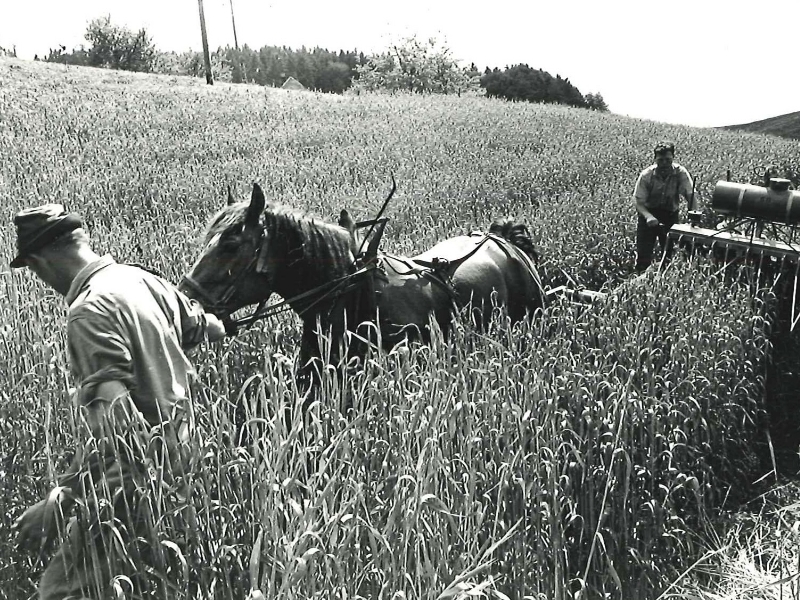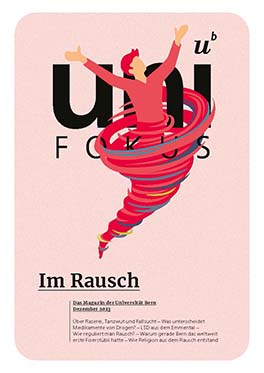History of Medicine
Arable land for LSD – ergot production in the hinterland
LSD is not only about hippies and self-experience trips, but also about farmers who produced ergot for the Basel chemical industry in their fields in the Emme Valley also commonly known as Emmental. The cultivation of the raw material for LSD also fundamentally changed the farming world.

The farmers of pre-industrial Europe lived in a state of almost permanent hallucination, stunned by hunger or by bread adulterated with hallucinogenic substances. The hallucinations triggered by the ergot were anything but intentional. In particular, rye bread, consumed by the poorer sections of the population, was often contaminated with ergot. Ergot (Claviceps purpurea) is a fungus that grows as a parasite on rye.
Bread made from rye infested with ergot led to epidemics caused by a disease known as Saint Anthony’s fire. Symptoms include seizures, skin lesions, psychotic disorders and dry gangrene which may cause fingers or toes to lose their sensation and rot.
From poison to medicine
For centuries, farmers did their best to remove the ergot from the harvested rye and suppress the growth of the ergot, for example by breeding rye varieties that were less susceptible to ergot infestation. At the beginning of the 20th century, ergot was suddenly put to medicinal use. It was then mainly used in obstetrics. Basel-based chemical and pharmaceutical company Sandoz had been a leader in this field since the 1920s. Because ergot triggers uterine contractions, it was used to stop postnatal bleeding, speed up delivery or trigger abortions, which is probably why it is called Mutterkorn in German, which literally translates as mother grain. Another common Swiss dialect term for ergot was “wolf’s teeth”.
With ergot now being used for medical purposes, the wolf’s teeth infesting the rye were collected by the farmers and delivered to Sandoz in Basel, where they were processed into medicinal preparations. Most of this naturally grown ergot originated in the Emme Valley, where it infected rye in the relatively humid climate.
Subscribe to the uniAKTUELL newsletter

Discover stories about the research at the University of Bern and the people behind it.
Cultivation battle for pharmaceutical company Sandoz
As a result, ergot became a scarce and expensive commodity. This is why Sandoz began growing ergot on farmers’ fields on an industrial scale in 1939. The artificial production of ergot was based on infecting the flowering rye ears with a spore suspension obtained by in vitro culture. In other words, the substance produced by Sandoz was injected into the ears of rye using needles – whether with a special “gun”, a small board or later a vaccination machine equipped with 16,000 needles – and the mother grains were later harvested by hand with a so-called sail or later with harvesters.
“The “wolf’s teeth” were collected by the farmers and delivered to Sandoz in Basel.”
This ergot campaign contrasts sharply with the collective memory of Switzerland, which remembers the Second World War as the time of the cultivation battle. After all, the cultivation of ergot made large quantities of rye unfit for human consumption. Ergot rye can no longer be used as bread grain and is only suitable as feed grain to a limited extent. What made it easier for the authorities to obtain approval was its economic importance: Even during the war years, Sandoz paid farmers several million francs to grow ergot, and many unemployed people found work in difficult times. As a result, ergot cultivation would evolve into the most important cultivation of pharmaceuticals in Swiss history from an economic point of view.
Patent rights and pesticides
Since Sandoz also owned a farm in Klus in Basel-Landschaft, the company also started farming rye itself. The work that ultimately led to a new variety of rye, particularly susceptible to ergot infestation, was immense. For the newly bred tetraploid Kluser rye, for example, only the five most promising “elite plants” had to be selected from 50,000 rye plants for further breeding.
Sandoz wanted to safeguard this enormous effort with new types of property rights.In the mid-1950s, for example, Sandoz informed the farmers it supplied with Kluser rye that they would not be allowed to use the rye cultivated by Sandoz for their own purposes, nor would they be allowed to keep, reuse or sell the seeds. In this respect, Sandoz tried to inject new property rights into its ergot rye, so to speak. Although there were no property rights to living organisms in Switzerland until the end of the 1970s, private property rights were increasingly given a higher weight than farmers’ rights of use in the breeding and cultivation of agricultural crops.
“The roots of flower power and biotech aren’t all that different.”
As an artificial variety, the Kluser rye bred by Sandoz required much more intensive manuring and more uniform production conditions than the varieties used up to that point. It was also more susceptible to other parasites and pests than ergot, and its cultivation therefore required new crop protection products – another area of Sandoz’s business.
The production of ergot was not only important for the history of plant breeding (Sandoz would later become Syngenta), but also for traditional biotechnology. After all, the ergot alkaloids could be produced by fermentation in bioreactors – once Sandoz had purchased a former brewery especially for this purpose. As a result, the cultivation of ergot in Swiss farmers’ fields was stopped rather abruptly in 1976. Sandoz thanked the farmers with a gold coin.
LSD and the technologicalization of agriculture
When LSD discoverer Albert Hofmann first synthesized LSD-25 from ergot at Sandoz in 1938, a small amount was used for animal experiments. As it did not show any special vasoconstrictive properties on the uterus of rabbits, the standard model for ergot experiments at the time, this substance was in danger of being forgotten. It was probably mainly due to the cultivation of ergot on an industrial scale that Hofmann resumed experiments with this substance in 1943. His documented self-experiment went down in history as the first LSD trip. But the new ways of agricultural production also played a role in his view of his “problem child” LSD, which had come about because of ergot. In retrospect, Hofmann himself tried to explain the drug wave that had swept through the USA since the late 1960s as a consequence of materialism, alienation from nature and the technologicalization of agriculture. He felt: “It’s no coincidence that LSD first came into circulation as a drug in the US, the country where industrialization, technologicalization, agriculture and urbanization are most advanced.” It seemed to have escaped his notice that ergot cultivation in Switzerland had made a decisive contribution to this process of chemization and technologicalization.
Considering how the raw material for LSD production was cultivated, LSD is not an antithesis to rampant materialism and the technologicalization of agriculture – but an active element in these processes of transformation. Seen in this light, flower power and biotech do not have such very different roots.
About the person

Beat Bächi
is currently conducting research in an SNSF-funded project on “Farm animals in the Anthropocene” at the University of Zurich. Prior to this, he worked at the Institute for the History of Medicine at the University of Bern, where Albert Hofmann’s legacy is made available to researchers and also where Bächi’s book “LSD auf dem Land. Produktion und kollektive Wirkung psychotroper Stoffe" (LSD in the Fields. Production and Collective Effects of Psychotropic Substances) (Konstanz University Press 2020) was written.
Magazine uniFOKUS

Subscribe free of charge now!
This article first appeared in uniFOKUS, the University of Bern print magazine. Four times a year, uniFOKUS focuses on one specialist area from different points of view.